I love ancient ruins and the Greco-Roman Ruins of Sicily and the temples in Segesta are remarkable and worth seeing.
Built about 410 B.C., the Greek Doric temple in Segesta located in northwestern Sicily is believed to be unfinished and it is unknown to whom it was to be dedicated.
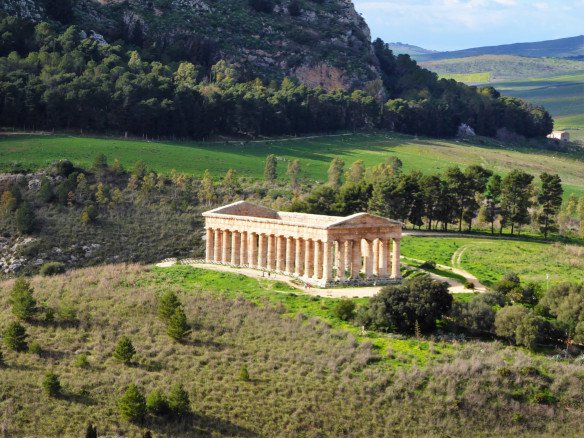
Greek Doric temple in Segesta, northwestern Sicily.
Sicily is renowned for many qualities: its luscious fruits and vegetables, varied and bountiful seafood, and drool-inducing pasta; the mountainous terrain, including Mt. Etna, Europe’s largest and most violent volcano; even for being “that weird-shaped ball” at the toe of Italy’s “boot.” But most people aren’t aware that Sicily has a rich and varied history, which includes centuries of occupation from many of the Mediterranean cultures: Phoenician, Carthaginian, Greek, Roman and Arabic, to name a few.
Perhaps because the Greeks and Romans were the last of the major pre-Christian civilizations to inhabit Sicily, their relics are most visible of those remaining on the island. In our three week ramble through Sicily, we sampled some of Sicily’s Greco-Roman past which included Segesta, Siracusa and beyond.
Siracusa
We were fortunate to have Alessio Patane of Sicily Grand Tour to take us through Siracusa-Ortigia and Agrigento. With his expert knowledge of Sicilian history in general, and specifically of the Greco-Roman period, we could fully appreciate the influence of these cultures on Sicily and Italy as a whole, and thus on our own modern, Western culture.
Primarily because I’m an unabashed history geek, I knew that Siricusa, founded 2,700 years ago as a Corinthian Greek colony, grew in size and importance to successfully rival Athens, once the mightiest of the Greek city-states of the period.. But I hadn’t realized just how extensive the Greek influence was within and beyond Siricusa.
The Corinthians first established their colony on the small island of Ortigia, which is now part of modern Siricusa. The earliest remains are of the Temple of Appollo, and columns of a Doric temple to Athena, which were incorporated into the walls of the cathedral.

The modern buildings of Ortigia ring the remains of the early 6th century BC temple to Appollo.

Doric columns from a 5th c. BC temple to Athena were incorporated into both the interior and exterior walls of the cathedral or duomo of Siracusa.
The gems of the Greek and Roman remains lie a couple of miles north in the now protected Parco Archeologico.

The Greek amphitheater at 138 meters across (151 yards) is the largest outside of Greece. First built in 5th century BC, it was rebuilt in the 3rd century BC.
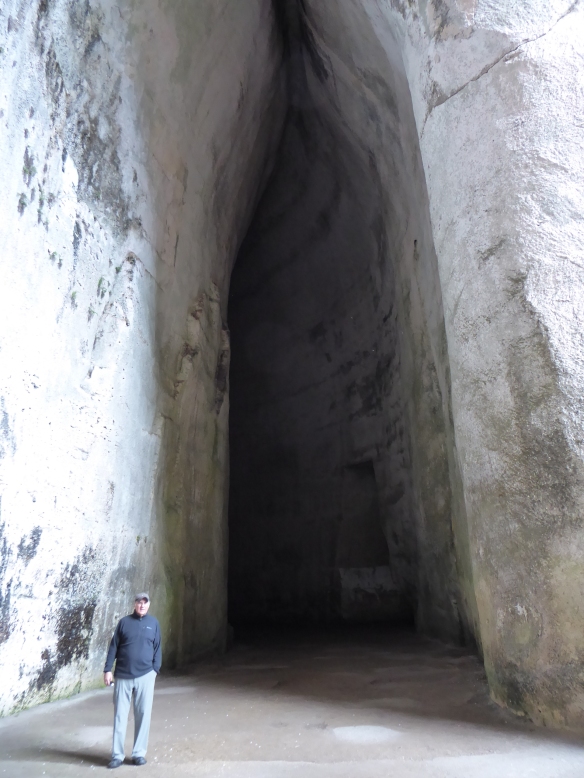
Near the amphitheater is the remains of a stone quarry where captives and slaves were forced to work the stone.
The shell-shaped interior cone of this formation enabled people at the top of the quarry to eavesdrop on what the captives below were saying. Supposedly the artist Caravaggio named it the Ear of Dionysus, after the Greek tyrant who ruled Siracusa in the 4th century BC and kept prisoners in the quarry.

Roman amphitheater from 1st century AD.
Unlike the Greeks who built their amphitheaters in the proscenium style, the Romans built round or elliptically shaped forums with several entry points and no single stage.
This difference in style reflects the Roman penchant for multiple forms of arena entertainment from gladiators battling each other or wild animals, even flooding the arena to stage mock sea battles. The Greeks, on the other hand, preferred theater, which was best suited to the proscenium style of amphitheater.
Valley of the Temples, Agrigento
Alessio took us also to Agrigento, in southwest Sicily, to view the magnificent temple ruins that stand along a ridge overlooking the Mediterranean. (It’s thus a mystery as to why this site was named the valley of the temples.)
Another interesting oddity is that the individual temples are still called by names given to them somewhat arbitrarily a century or more earlier, when more modern research clearly states most of the temples’ dedications were unknown. Nevertheless, the temples of Agrigento are spectacular.

Although Greek in origin, in the Doric style, these remains are called the Temple of Juno (Greek name, Hera), from about 450 BC.

Almond trees line the roadway along the mountain ridge known as the Valley of the Temples. The well-preserved Temple of Concordia is seen in the center, with the Mediterranean to the center left.

Temple of Concordia, built about 440 BC in the Doric style. It is the best preserved of the temples probably because it was used as a church for several centuries.

The temple of Hercules, from about 6th century BC, is one of the oldest in Agrigento.
Taormina
One of the most impressive settings for the Greco-Roman Ruins and ancient sights we saw was the 3rd century BC Greek amphitheater in the hill town of Taormina. How can you beat the view of smoking Mt. Etna and the Mediterranean Sea as part of the backdrop to the stage?

The remains of the stage area of the Greek amphitheater in Taormina, with Mt. Etna in the background. Later under Roman rule, this area of the amphitheater was incorporated into a wealthy family’s villa; even later, thousands of stones were hauled away for use in constructing other buildings. Centuries later, what could be recovered of the original theater is what is seen here today.
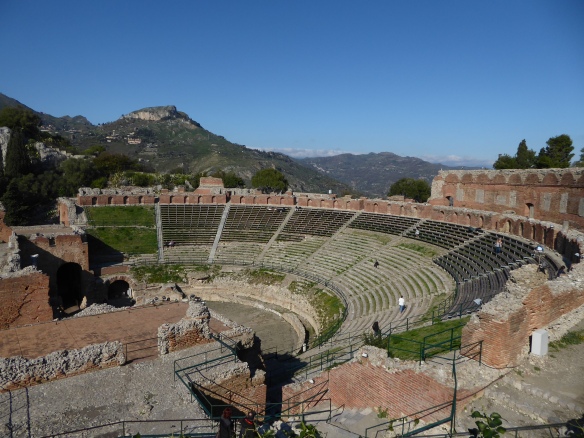
The seating area of the proscenium amphitheater in Taormina.
Segesta
The fabulous Doric Greek temple in Segesta was one of the great surprises of our trip. We decided to check it out on our way to Erice, northwestern Sicily, and as often happens with the unexpected, we were astounded. The temple in Segesta was featured above as the lead photograph, from the top of another, higher hillside which featured a Greek amphitheater as well as the ruins of a medieval church and a mosque.

Segesta
The magnificent temple, uncompleted, whose function and dedication has remained unknown. The stone columns have remained in remarkable shape.
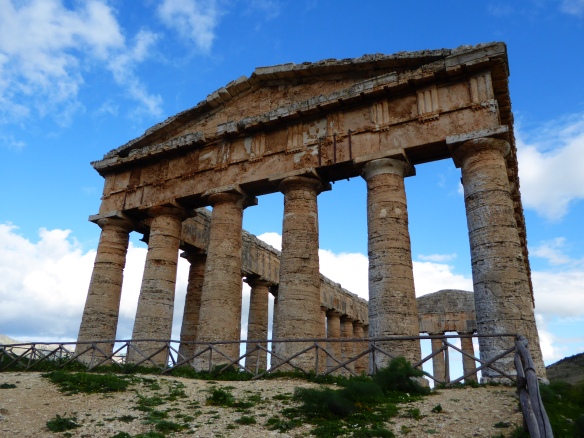
Segesta
Both the front and back facades have been well protected. The tipani at both ends of the temple are well preserved.
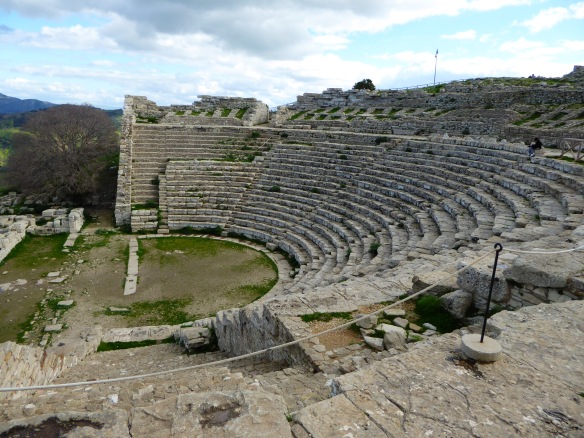
Hilltop Greek amphitheater, possibly the 3rd or 2nd century BC – Segesta.
Mosaics of the Villa Romana del Casale
Not all the reminders of Greece and Rome are temple ruins. We visited a semi-recovered Roman villa in the mountains of central Sicily that had some of the most beautiful and well-preserved floor mosaics I’ve ever seen.
While archaeologists can date the construction to early 4th century AD, the exact identity of the owner of this 3,000 square meter dwelling is unclear, other than he must have been wealthy and in the upper Roman hierarchy of his time. What is clear is that the rooms of mosaics were preserved due to an enormous landslide in the 12th century which destroyed the second level of the villa but covered and thus protected the ground floor’s mosaics over the ensuing centuries.
Dusk was already falling when we entered the villa’s remains, where we walked along raised cat-walks and peered down through the gloom at the mosaic floors. Yet despite the centuries, the avalanche of mud, and poor lighting, the beauty and colors of the mosaics were readily visible.

The majority of mosaics we saw were in ground level rooms off the four sides of the peristyle, the villa’s open courtyard surrounded by a columned portico.

These mosaics are on the floor under the shaded portico. From the hall residents of the villa could enter private interior rooms, all with their own mosaic floors.

Conflict through the ages…

Many of the mosaics (see above and below) featured elaborate hunting scenes — or were scenarios depicting the capture of exotic animal specimens to exhibit in Rome or to set loose on gladiators in the great Colosseum.
In addition to the rhinoceros and hippopotamus featured here, nearby mosaics showed lions, tigers, panthers,giraffes and leopards being rounded up and boarded onto ships for the long sea trip back to Rome.


Lithe young women in bikinis never fail too attract!
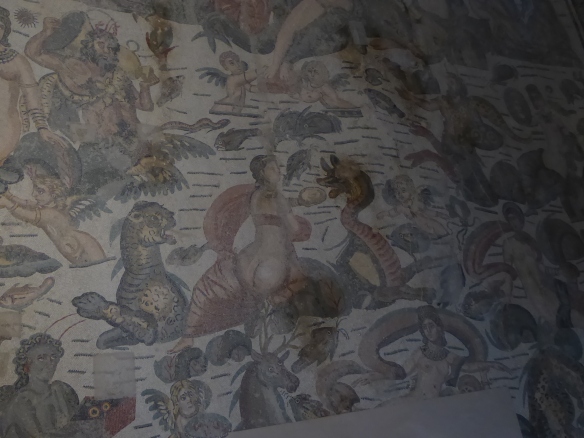
Some of the floor mosaics depicted incredible range of subject matter, style and detail. Such a variety suggests to archaeologists and scholars that many artists of different designs and backgrounds contributed to the mosaics.
By no means is Sicily’s Greco-Roman past limited to these few archaeological sites but Segesta is a real gem and should not be missed. If you’re a history lover, you’ll want to see them all. It’s probable that many relics remain, either destroyed as later civilizations built upon them, or simply buried by lava, landslides or earthquakes and are as yet waiting discovery.

Carol Barbier Rolnick grew up in Japan and Southeast Asia, traveling extensively as a child through Asia, the Mideast and Europe on family vacations. Travel has continued as a priority through raising kids and continuing into retirement, extending adventures through the Americas, southern Africa, Asia, and repeat trips throughout Europe. Carol and her husband, Michael spent four summers based in Utrecht, The Netherlands, which has become like a second home. They are (still) aiming towards Australia-New Zealand and Antarctica to round off their continental travels.








